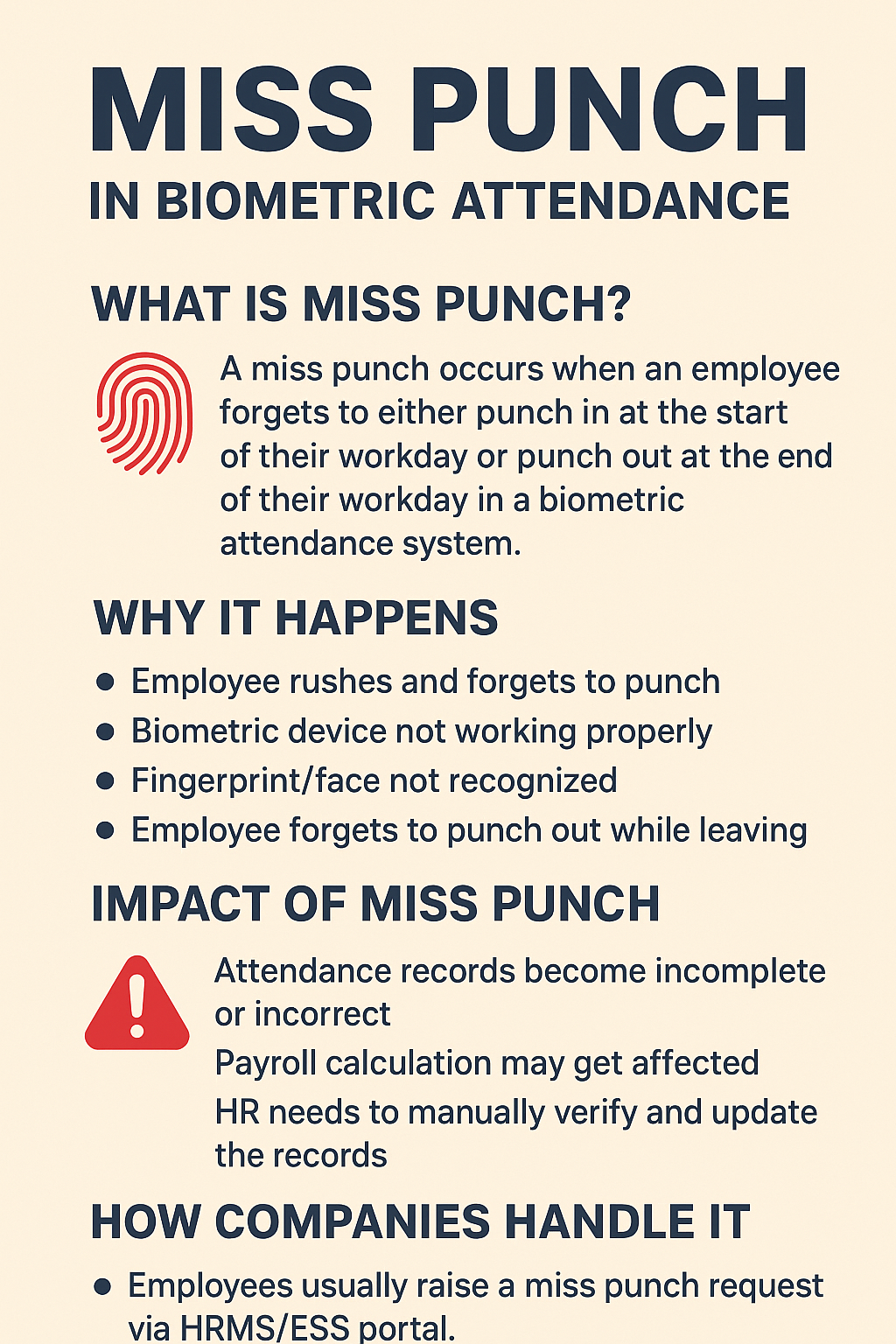Introduction
Attendance management is one of the most critical aspects of workforce management. Organizations rely heavily on biometric systems, swipe cards, or digital attendance platforms to track employee working hours. But what happens if an employee forgets to mark their attendance while entering or leaving the office?
This is where the Miss Punch Application comes into play. A miss punch occurs when an employee unintentionally forgets to “punch in” or “punch out,” leading to incomplete or inaccurate attendance records. The Miss Punch Application provides a structured way for employees to raise a request to correct such attendance errors, ensuring accuracy in payroll and compliance.
In this blog, we will explore everything about the Miss Punch Application—its meaning, features, benefits, and how organizations can implement it effectively.
What is a Miss Punch Application?
The Miss Punch Application is a formal request made by an employee to the HR or Admin department for correcting their attendance record when they forget to log in or log out of the system.
For example, if an employee comes to the office on time but forgets to punch in on the biometric device, their attendance system might show them as absent. In such a case, they can submit a Miss Punch Application explaining the situation and requesting the HR/Admin team to correct it.
This application acts as proof and ensures that employees are not penalized unfairly for genuine mistakes.
Why is the Miss Punch Application Important?
The Miss Punch Application plays a vital role in maintaining transparency and accuracy in employee attendance records. Here’s why it is important:
- Accurate Payroll Processing
- Attendance directly impacts salary calculations. Incorrect punch records can lead to unnecessary salary deductions.
- A Miss Punch Application ensures accurate payroll based on actual working hours.
- Employee Trust and Fairness
- Employees feel secure knowing that genuine mistakes can be corrected.
- Builds trust between the workforce and the HR department.
- Compliance and Record Maintenance
- Proper documentation of missed punches ensures organizations comply with labor laws and company policies.
- Provides an audit trail for attendance corrections.
- Productivity and Engagement
- Employees spend less time worrying about attendance errors.
- HR saves time as the process becomes systematic and automated in some cases.
Common Reasons for Miss Punches
Miss punches usually happen due to:
- Forgetting to punch in while entering in a hurry.
- Technical glitches in biometric devices.
- Power or network failure during login/logout.
- Employees working remotely and forgetting to mark attendance online.
- Emergency situations where the employee directly joins work.
How to Write a Miss Punch Application
A well-written Miss Punch Application should be:
- Clear and Polite
- Include Date & Time of the Missed Punch
- State the Reason
- Request for Correction
Example Format:
Subject: Request for Attendance Correction – Missed Punch
Dear [Manager/HR Name],
I would like to bring to your notice that on [Date], I forgot to punch [In/Out] due to [reason, e.g., urgent client call]. However, I was present in the office during working hours.
I kindly request you to correct my attendance for the mentioned date.
Thank you for your understanding.
Regards,
[Employee Name]
[Employee ID/Department]
Digital Miss Punch Applications – HRMS Integration
In modern workplaces, many HRMS (Human Resource Management Systems) provide built-in Miss Punch Application modules. Instead of manual emails, employees can directly raise attendance correction requests via mobile apps or portals.
Features of a Digital Miss Punch Application:
- Self-Service Portal – Employees can raise requests themselves.
- Approval Workflow – Managers/HR approve or reject with comments.
- Automated Updates – Once approved, the system auto-corrects attendance.
- Transparency – Employees can track request status.
- Audit Trail – Maintains a log for compliance.
Benefits of Miss Punch Application for Organizations
- Saves HR Time
No manual corrections or back-and-forth emails. - Prevents Payroll Disputes
Reduces conflicts regarding salary deductions. - Boosts Employee Morale
Employees know genuine issues will be resolved fairly. - Reduces Errors
Automated systems minimize manual mistakes. - Ensures Discipline
While genuine cases are approved, frequent miss punches can be flagged to avoid misuse.
Challenges with Miss Punch Applications
- Misuse by Employees – Some may take advantage of the system.
- Approval Delays – If managers delay approvals, payroll issues may still occur.
- Policy Clarity – Lack of clear guidelines can cause confusion.
Best Practices for Implementing Miss Punch Applications
- Define a Clear Policy – Specify how many miss punches are allowed per month.
- Use HRMS Software – Automate the process for accuracy and efficiency.
- Approval Workflow – Involve both reporting manager and HR for checks.
- Employee Training – Educate staff about the right way to apply.
- Monitor Patterns – Identify employees who frequently miss punches.
Role of Miss Punch Application in Payroll & Compliance
- Attendance errors directly affect salary calculation, overtime, and leave deductions.
- A Miss Punch Application ensures payroll compliance under labor laws.
- Maintains records for future audits and dispute resolutions.
Future of Miss Punch Applications
With advanced HRMS platforms and biometric systems, the future of Miss Punch Applications is:
- AI-based detection of irregular punches.
- Mobile push notifications reminding employees to punch.
- Geo-fencing for remote workers to ensure location-based attendance.
Conclusion
The Miss Punch Application may look like a small process, but it plays a significant role in ensuring transparency, fairness, and accuracy in attendance management. For employees, it safeguards their salary from unnecessary deductions. For employers, it builds trust and maintains compliance.
As workplaces move towards digital HRMS solutions, Miss Punch Applications are becoming faster, more transparent, and less prone to errors. Implementing this system is no longer optional—it’s a must for modern organizations that value both efficiency and employee satisfaction.
